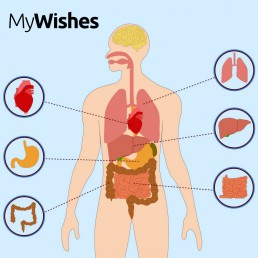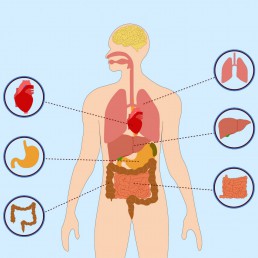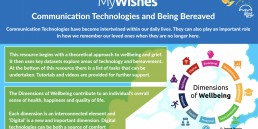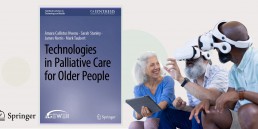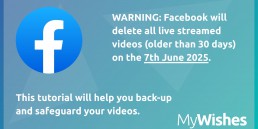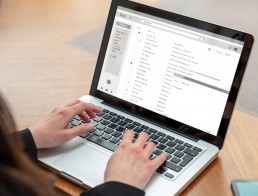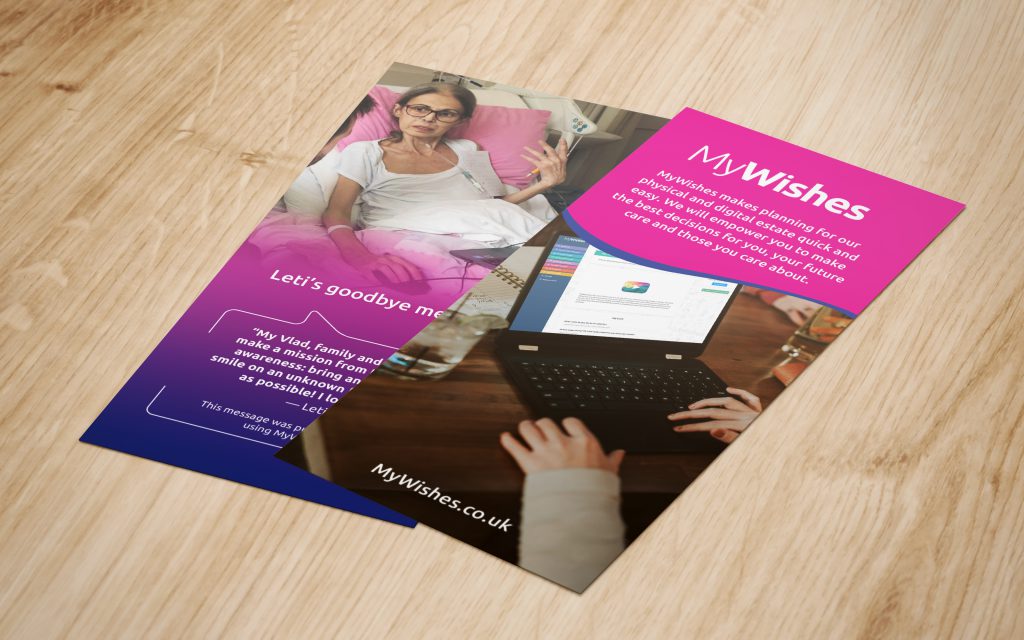Organ Donation and leaving a legacy
Organ donation as a living legacy
Legacies can be left online, offline and in a number of different ways. The selfless act of being an organ donor and passing on one or more organs is one of the most powerful legacies that someone can leave. One organ donor can save up to eight lives. The same donor can also improve the lives of up to 50 people when opting to donate their tissues and eyes.
If you would like to become an organ donor you should register to become one. Once registered it is paramount that you tell a friend or family member your wishes. This will help ensure that your wishes are adhered to should something happen to you unexpectedly.
The importance of telling someone your wishes
In the UK three people die every day due to a shortage of available organs. Many lives will be saved if more friends and families agree for their loved one’s organs to be donated. It is very important that you tell your friends and family your organ donation wishes.
Who can become an Organ Donor?
It is a common misconception that a range of individuals are ineligible to be an organ donor. These reasons sometimes include age, smoking, drinking or have certain, pre-existing medical conditions. In some circumstances organs cannot be donated however misinformation around this area costs lives and prevents people who would otherwise be able to donate their organs from doing so. To learn about restrictions currently in place click on the country where you live:
Organ Donation fact buster
- There is no age limit for becoming an organ donor.
- Having a tattoo does not prevent you from becoming an organ donor.
- Drinking alcohol does not prevent you from becoming an organ donor.*
- There is no age limit for becoming an organ donor.
- It is still possible to become an organ donor if you smoke.
- Having a tattoo does not prevent you from becoming an organ donor.
- Drinking alcohol does not prevent you from becoming an organ donor.
If you are still unsure of your eligibility and would like to donate, please contact your GP. Your GP will be able to guide you through your options based upon your current circumstances.
Organ Donation conversations
In England, just 45% of families agree to organ donation going ahead if they are unaware of their loved one’s decision to be a donor. This figure rises to 95% when they are aware of their decision.
It is important to have an open and honest conversation about your organ donation preferences with those who are close to you. By doing so, your wishes are more likely to be adhered to.

Register to be an Organ Donor
Becoming an organ donor is an altruistic and selfless act. It can benefit individual recipients, those closest to you, and society at large. If you decide that you would like to become an organ donor you should confirm this within the country where you live.

“Tell those closest to you that you want to donate your organs after you die to help some of the 10,000 people in the UK currently in need of a life changing organ transplant.” – Sally Johnson, NHS Blood and Transplant’s Director of Organ Donation and Transplantation
How to document your organ donation wishes within your Advance Care Plan
Document your organ donation wishes within your Advance Care Plan
Once you have registered as an organ donor you should include this information within your Advance Care Plan. It is quick, easy and free to do this on MyWishes. Simply register or sign in to your MyWishes account and navigate to the ‘My Advance Care Plan’ section. Here you will be able to document your organ donation, future health and social care wishes.
Once completed, email the document to loved ones, your GP and anyone who might be involved with your care now or at some point in the future. If you have a printer, you should also print the document and keep it in a safe and accessible place.

Our latest tutorials
Share this article...
MyWishes free to use software was developed under the guidance of healthcare, hospice, legal and funeral professionals. Our platforms empowers society to make plans for both themselves and those they care about.

Michael Sobell Hospice Palliative Care Department Mount Vernon Hospital, Gate 3 Northwood HA6 2RN United Kingdom (Map)
- Register and document your wishes for free here
- For all enquires click here
- To learn how MyWishes works click here
How to send funeral invitations by email
Overview
Inviting people to a funeral can be a stressful and a daunting task. Speaking to close friends and family members face to face is often the most appropriate way to invite loved one’s to a funeral once a date has been set.
Sending email invitations and using social networks can also be an alternative and suitable way to quickly share information about where and when a funeral or cremation is due to take place. The information shared might be similar to the type of information traditionally included within the announcements section of a local newspaper.
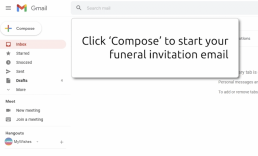
Sending funeral invitations by email - Video tutorial
Subject Line and Message
It is important that the subject line in the email is filled in and relevant to the announcement. You might for example, want to use the following subject line:
“The death of (insert full name) and (first name)’s upcoming funeral”
Write the details of the funeral, cremation, celebration of life or wake in the ‘body’ of the email. We recommend writing the content of the email first before adding the list of email recipients. This will reduce the likelihood of sending the email by mistake before it has been completed.
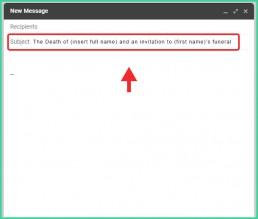

Using 'BCC'
When sending funeral invitations to a large number of email contacts, we recommend that you send the emails using ‘BCC’ instead of ‘TO’ or ‘CC’ (please see the image for further reference)
By using ‘BCC’ each email recipient will not be unable to view the email addresses of other people who have also been sent the same email.
You might feel that sending emails is not be suitable. This decision should be made by a close friend or family member of the person’s whose funeral is taking place. Sending one email announcement email using ‘BCC’ can however save a lot of time and reach a lot of people during a very stressful time. You might also be interested in learning ‘How to arrange and video stream a funeral on Facebook‘
Email addresses provided by businesses, broadband and TV suppliers
There are a range of issues associated with using email addresses provided by broadband and TV providers (such as Virgin, EE, BT etc). As a general rule of thumb, we recommend that you do not use email services provided by any broadband providers for two main reasons:
- If you decide to leave their service they will often close the email account or charge you to keep your email account active (each month).
- When an account owner dies they might not keep the account active (unless someone keeps paying them to do so).
If a loved one dies and you have access to their email account (hosted by their broadband/TV supplier) it might be removed when the billing is cancelled. You may therefore decide to postpone cancelling the account for a period of time.
If a loved one had a ‘work email’ the account might be closed by the employer following their death. You might want to speak with the person’s former employer and request that it remains active for an extended period of time. Employers might also be able to insert an ‘Out of Office’ message to the account. The content of this message might be agreed by a friend or family member.

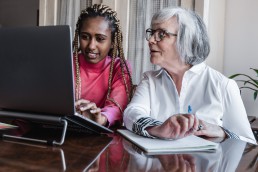
What happens when an email account is closed?
Once an account is closed, no emails will be accepted or received. Previously shared emails will no longer be accessible (unless downloaded locally to a laptop, mobile phone or other device). This can be problematic for assigned partners, children etc acting as ‘digital executors’ trying to retrieve online content, closing online billing accounts etc.
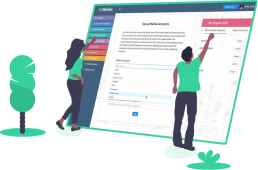
MyWishes free to use software was developed under the guidance of healthcare, hospice, legal and funeral professionals. Our platforms empowers society to make plans for both themselves and those they care about.

Michael Sobell Hospice Palliative Care Department Mount Vernon Hospital, Gate 3 Northwood HA6 2RN United Kingdom (Map)
- Register and document your wishes for free here
- For all enquires click here
- To learn how MyWishes works click here
How to 'tag' physical photos
Where the term 'tagging' came from
The term ‘tagging’ is rooted in graffiti culture and was adopted in the late 1970s. Graffiti artists would ‘tag’ their name or their alias name on walls, trains and other public places in order for their work to be seen.
Social media 'tagging'
The term ‘tagging’ was recently mass adopted in the online world with the arrival of Flickr, Facebook and other social media sites that host peoples photos. The word ‘tagging’ is now most commonly used in the context of assigning (tagging) someone’s name when their face appears in a photo.


Facebook tagging example
The image to the left highlights what a ‘tag’ looks like when it is applied to someone face on Facebook. Once tags are added to a photo they become easier to manage, to find and view photos of other Facebook friends. In this sense it helps to us to collaboratively manage our photos online for both us and our friends.
How to 'tag' physical photos
The act of ‘tagging’ physical photos can help ensure that friends and family members who have had an impact in our lives are not forgotten overtime.
To tag a loose photo simply write the peoples names who are in it and other pieces of information surrounding the photo on the back of the photo. This task can be a great way to help ensure that stories and family history is remembered and retold. This can be a worthwhile task for carers of the elderly and those suffering with dementia to undertake. Once photos have been tagged friends, family members and carers can revisit the task with an individual to help evoke memory and improve facial recognition.
You may want to write information directly onto photos or onto photo albums if they are already mounted. This will again help to add context about the people and the events that were captured. You might also consider writing about a collection of photos at the start or back of a photo album. If an album is full of photos extra pages of paper can be stapled to it to help ensure that the writings remain with the photos and is not removed or lost overtime.
By tagging physical photos and photo albums you can help ensure that stories captured within photos have a life beyond the death of the owner. Furthermore, the sentimental value of the photos and photo albums may increase due to the personal information and context provided within them.


MyWishes free to use software was developed under the guidance of healthcare, hospice, legal and funeral professionals. Our platforms empowers society to make plans for both themselves and those they care about.

Michael Sobell Hospice Palliative Care Department Mount Vernon Hospital, Gate 3 Northwood HA6 2RN United Kingdom (Map)
- Register and document your wishes for free here
- For all enquires click here
- To learn how MyWishes works click here
Sharing is caring…
How to plan for death (digitally)https://t.co/mlb8CEFtfk #DMAW2021 #InAGoodPlace
— MyWishes (@MyWishesApp) May 14, 2021

